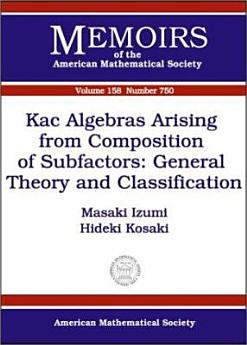Kac Algebras Arising from Composition of Subfactors: General Theory and Classification: General Theory and Classification
Masaki Izumi · Hideki Kosaki
Jan 2002 · American Mathematical Soc.
Ebook
198
Pages
reportRatings and reviews aren’t verified Learn More
About this ebook
We deal with a map $\alpha$ from a finite group $G$ into the automorphism group $Aut({\mathcal L})$ of a factor ${\mathcal L}$ satisfying: $G=N \rtimes H$ is a semi-direct product, the induced map $g \in G \to [\alpha_g] \in Out({\mathcal L})=Aut({\mathcal L})/Int({\mathcal L})$ is an injective homomorphism, and the restrictions $\alpha\!\!\mid_N,\alpha\!\!\mid_H$ are genuine actions of the subgroups on the factor ${\mathcal L}$. The pair ${\mathcal M}={\mathcal L} \rtimes_{\alpha} H \supseteq {\mathcal N}={\mathcal L}^{\alpha\mid_N}$ (of the crossed product ${\mathcal L} \rtimes_{\alpha} H$ and the fixed-point algebra ${\mathcal L}^{\alpha\mid_N}$) gives us an irreducible inclusion of factors with Jones index $\ No. G$. The inclusion ${\mathcal M} \supseteq {\mathcal N}$ is of depth $2$ and hence known to correspond to a Kac algebra of dimension $\ No. G$.A Kac algebra arising in this way is investigated in detail, and in fact the relevant multiplicative unitary (satisfying the pentagon equation) is described. We introduce and analyze a certain cohomology group (denoted by $H^2((N,H),{\mathbf T})$) providing complete information on the Kac algebra structure, and we construct an abundance of non-trivial examples by making use of various cocycles. The operator algebraic meaning of this cohomology group is clarified, and some related topics are also discussed. Sector technique enables us to establish structure results for Kac algebras with certain prescribed underlying algebra structure.They guarantee that 'most' Kac algebras of low dimension (say less than $60$) actually arise from inclusions of the form ${\mathcal L} \rtimes_{\alpha} H \supseteq {\mathcal L}^{\alpha\mid_N}$, and consequently their classification can be carried out by determining $H^2((N,H),{\mathbf T})$. Among other things we indeed classify Kac algebras of dimension $16$ and $24$, which (together with previously known results) gives rise to the complete classification of Kac algebras of dimension up to $31$. Partly to simplify classification procedure and hopefully for its own sake, we also study 'group extensions' of general (finite-dimensional) Kac algebras with some discussions on related topics.
Rate this ebook
Tell us what you think.
Reading information
Smartphones and tablets
Install the Google Play Books app for Android and iPad/iPhone. It syncs automatically with your account and allows you to read online or offline wherever you are.
Laptops and computers
You can listen to audiobooks purchased on Google Play using your computer's web browser.
eReaders and other devices
To read on e-ink devices like Kobo eReaders, you'll need to download a file and transfer it to your device. Follow the detailed Help Center instructions to transfer the files to supported eReaders.




